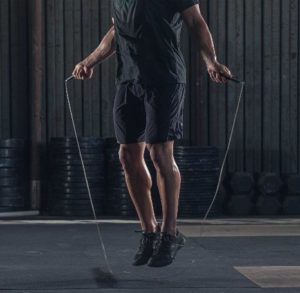Might as Well Jump…Jump!
If you’re looking for a new way to add a little creativity to your workouts, consider adding jump rope intervals. A good jump rope is one of the best investments you can make in your own fitness because it is an extremely effective form of cardiorespiratory exercise and does not require much more than a little  space, a timing device, and your ingenuity.
space, a timing device, and your ingenuity.
The average person burns about five calories to consume one liter of oxygen. Keeping this in mind, exercises that involve moving more muscles at one time can increase the demand for oxygen, allowing you to expend more energy (i.e., burn more calories). Below are a few reasons why you should consider jumping rope when looking for ways to boost your existing fitness program:
*1. Jumping rope can increase the elasticity and resiliency of lower-leg muscles, leading to a reduced risk of lower-leg injuries. Calf raises can strengthen the lower leg, but if the muscle tissue becomes too tight it could increase the risk of a number of lower-leg injuries, including Achilles tendon strain or plantar fasciitis. Jumping rope regularly strengthens the calf muscles and improves the elasticity of the surrounding tendons and fascia. To increase elasticity, try to land on the ball of the foot first, but let your heels go all of the way down to the ground.
*2. Jumping rope can help improve your coordination. Jumping rope is a cyclic activity, which means you perform it for a steady, regular cadence. The steady cadence and rhythm of jumping rope can help improve the coordination between your eyes, feet, and hands.
*3. Jumping rope can help improve your cognitive function. Jumping rope can involve learning new motor patterns, which improves the nervous system communication between your brain, wrists, and lower leg muscles. This may improve your overall cognitive function, which is an important benefit as we age.
*4. Jumping rope can help increase the intensity of circuit-training workouts. Adding one or more jump-rope stations to a strength-training circuit is an easy way to increase the intensity of the overall workout, thereby increasing your heart rate and providing a cardiorespiratory benefit. Add two to three minutes of steady rope jumping at the end for an additional calorie-burning opportunity.
- Jump ropes are extremely portable. Most modern hotels provide guests with a basic workout room that features a few pieces of exercise equipment. However, many are under-equipped if you enjoy more intense workouts. If you pack a jump rope in your suitcase, even the most sparsely outfitted hotel fitness facility can provide you with the space for a sweat-filled jump-rope session. Also, jumping rope is an excellent option for outdoor workouts at a park or exercise course. Many city parks have pull-up bars and other outdoor exercise facilities. With a jump rope, you can get a total-body workout by combining your favorite exercises on the available equipment with one- to three-minute jump rope intervals.
If you are thinking about making jumping rope a component of your personal workout program it’s a good idea to invest in a good, durable jump rope. *Purchasing a jump rope is not a significant investment, but you should spend a little to invest in a rope that is easy to adjust and that uses ball bearings to connect the rope and the handle. Ropes with bearings tend to last a little longer than ropes that simply have the end knotted in the handle. The only other item you need is a timer to use to set specific work-to-rest ratios.
Do not forget to Warm-up!
*Perform multiplanar jumps by jumping in all three planes of motion. This helps prepare the muscles and connective tissues of your lower legs for the forces they will experience during the workout. Perform eight to 10 jumps, rest for 30 seconds, and perform two sets for each plane.
Split-leg Jumps (Sagittal Plane): Start with your right foot forward and left foot back. As you jump, move your left foot forward and right foot backwards before landing.
Wide-to-narrow Jumps (Frontal Plane): Jump the feet out to shoulder-width apart and then directly under the hips.
External-to-internal Rotation Jumps (Transverse Plane): Jump up and rotate your right foot to point toward 2 o’clock and the left foot toward 10 o’clock when you land. As you jump back up, rotate the feet to point to 12 o’clock. To protect your knees, do not over rotate your feet and be sure to land with your knees slightly bent.
Do not forget to Cool-down!
Calf Stretch: Lean against a wall and place your right leg straight back. Keep your hands on the wall and press the right heel into the floor while keeping the knee fully extended. Hold for 30 to 45 seconds and complete two to three reps on each side.
Quadriceps Stretch: Lie on your right side and hold the top of your left foot in your left hand, with your left knee pointed straight down your right leg. Hold for 30 seconds and then switch.
*(Reference: American Council on Exercise)



